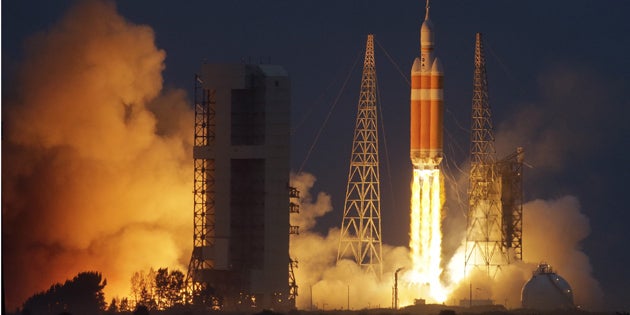Geology professor Cassandra Runyon is one of approximately 20,000 people at Florida’s Cape Canaveral Air Force Station’s Space Launch Complex. This
morning, on December 5, 2014, she left her hotel room at 2 a.m. to watch the launch of NASA’s Orion spacecraft, the first launch of a spacecraft with the capacity to send humans outside of Low Earth Orbit (LEO) since Apollo 17 landed on the moon in 1972.
“We were all taking bets about how delayed it would be, but no one won because Orion launched right on time at 7:05 a.m.,” she said. “NASA started the countdown at four minutes, and by 20 seconds the entire crowd was counting down. First the main engine went off, then this ball of fire erupted under the spacecraft. From liftoff, it took 14 seconds for Orion to clear the launchpad and then it was off.”
Orion was supposed to launch December 4 but delayed due to weather concerns. Its structure is based largely off the Apollo 17 spacecraft, and it is touted as taking humans one step closer to visiting planets such as Mars.
The crowd had thinned by about 10 percent, Runyon estimates, between the initial launch date and the delayed date, but it had not waned in its enthusiasm. “It’s so exciting to be here right now! The mood is jovial,” she said.
Runyon is the College’s S.C. Space Grant Consortium director. She co-teaches a course called NASA Space Mission Design with astronomy professor John Hakkila. In the course, which is open to all disciplines, College of Charleston students work with engineering counterparts at the University of Alabama at Huntsville to write a proposal and design a mission to an assigned planetary body – this year it’s Jupiter’s moon Europa.
ARTICLE: Learn more about Hakkila in this College of Charleston Magazine article.
“Learning about the Orion spacecraft and what the U.S. plans to do with it will help our students back in the classroom,” she said. While hearing details about the launch may be thrilling for her NASA Space Mission Design students, the most exciting thing for Runyon is that “it puts the U.S. back in space. We’re way behind other countries in terms of space exploration, and advances like this could make it possible for some of the students we’re encouraging to study sciences to actually live in space someday. I’ll live in space if I can!”
This fact – that Orion makes the U.S. competitive in space exploration for the first time in decades – made the launch standout to Runyon, who has attended three American spacecraft launches and one Indian launch.
VIDEO: Hear from student Heather Meyer about her internship at NASA’s Goddard Space Flight Center.
Alumnus David Weiss ’12 took the principals he learned in the space mission design course to Brown University where he’s working toward his doctoral degree. Weiss, who spent several weeks at the Mars Desert Research Station in Utah and who hopes to make the long journey to Mars one day, describes the Orion launch as incredibly significant.
“It’s great that NASA is working to get us out of low earth orbit and start exploring deep space. Orion could pave the way for future spacecraft capable of manned lunar and Martian landings.”
ARTICLE: Read a College of Charleston Magazine article about Weiss.
While Runyon plans to focus her Orion experience locally (“In our state, we’re all trying to educate students and public about NASA, about the resources it makes available and all the good that it’s doing. By being here we can take that back for student and faculty research”), Weiss hopes the advances that result from the launch take him as far away as possible.
“Planetary science is all about exploration, so I’d be remiss if I didn’t also apply for the Astronaut Corps,” Weiss said. He notes that a Mars mission is at least a decade away, slated for sometime in the 2030’s, giving him ample time to hone his expertise.
Whether or not Weiss is one of the first humans to walk on Mars, though, both he and Runyon agree the Orion launch is a monumental step towards deep space exploration. “It bodes well,” Weiss said. Runyon agreed, “It’s very encouraging. The launch was phenomenal. By designing and testing this technology, we are advancing science in the U.S. by leaps and bounds.”






